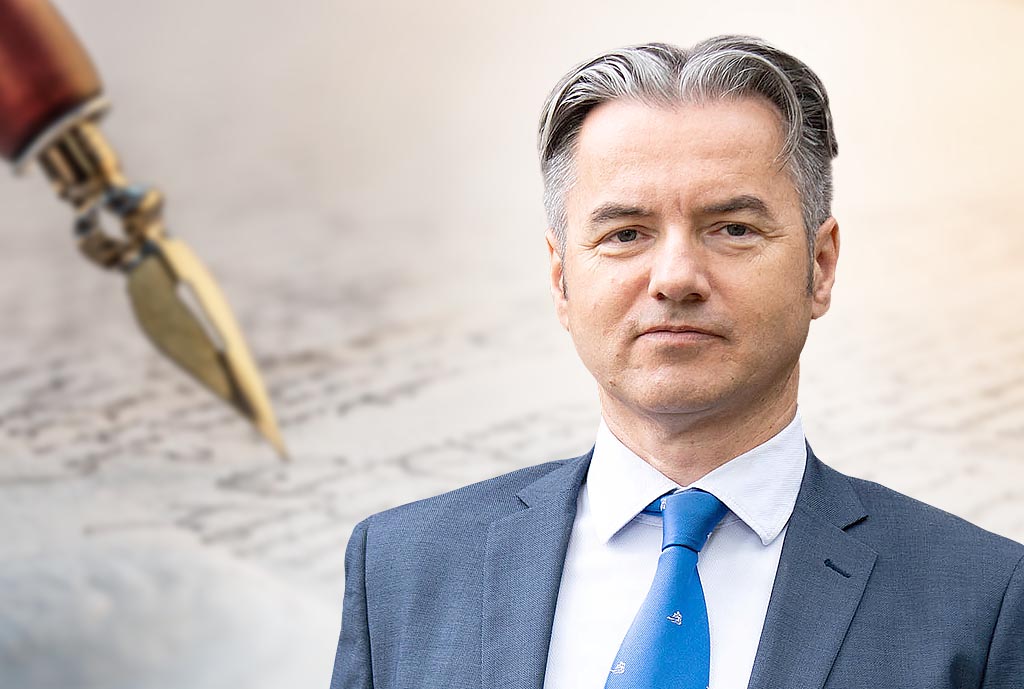By: Dr Metod Berlec
In Slovenian history, there are many who are responsible for the Slovenian nation gradually maturing politically and achieving independence in 1991. One such person is undoubtedly the Catholic priest, ethnographer, linguist, and national awakener Matija Majar Ziljski.
The Springtime of Nations in 1848 allowed Majar to openly express his national feelings for the first time, which he previously had to hide from the Austrian regime. This regime was personified by Chancellor Klemens von Metternich. On March 17th, 1848, the day when news of the revolution in Vienna reached Klagenfurt, Majar wrote the famous article “What Do Slovenians Demand?” The article was published on March 29th in Bleiweis’ Agricultural and Handicraft News. In this article, he was the first to set forth the fundamental demands of the Slovenian national movement: the introduction of Slovenian language in schools and offices, and the unification of Slovenian lands within the Austrian monarchy into one entity. On December 26th, 1848, he further presented a plan in the newspaper Slovenia for the reorganisation of the monarchy into a federal state of nations. Majar thus clearly directed all his efforts towards the fight for a United Slovenia. Due to various historical and geopolitical reasons, we Slovenians were not able to achieve the unification of all Slovenian lands into one unit, but under the leadership of the Demos coalition and its leader Dr Jože Pučnik, we managed to achieve the independence of the Republic of Slovenia in the years 1990-1992.
In this issue of the magazine, we pay special attention to Slovenian independence and the 33rd anniversary of the War for Slovenia. Although it has been called the “Ten-Day War”, it lasted with varying degrees of intensity from the disarmament of the Slovenian Territorial Defence (by the federal army and its loyal red helpers) in mid-May 1990 until the withdrawal of the last Yugoslav soldier in October 1991 from Slovenia. The President of the Demos independence government, Lojze Peterle, in an interview for our magazine, says that “independence was not a project of the Party (‘avant-garde’)”. He adds: “With the state-building idea, the spring political forces came forward, while the old ones offered Slovenia a future in Yugoslavia. However, the successor of the ZKS in the then assembly supported the plebiscite law and signed the related party agreement. Here we can talk about unity. Kučan also respected the outcome of the first democratic elections, and later, as the supreme commander, signed the declaration of demilitarisation when we were in the critical time of preparing for defence. It is important that the old structure did not go frontally against independence, but it did not lead it. In the elections, DEMOS won with the project of independent statehood and took on the key political responsibility for independence.” The Demos government thus followed the May Declaration of 1989, which clearly stated in its first point the aim for a sovereign state of the Slovenian nation. As Dr Jože Možina emphasises, “there are very few nations in the world that achieved their statehood in such a democratic way as we Slovenians did with the defensive war, which is significant precisely because it claimed relatively few casualties, although of course, every life lost is a tragedy”. “Thus, the independence war together with the plebiscite six months earlier symbolises our unity and is a lasting inspiration for the future.”
Of course, we cannot be satisfied with the current state under the present leftist, anti-Slovenian, and harmful Golob government. In this regard, it is possible to agree with the Minister of Defence during the independence period, former Prime Minister, and SDS President Janez Janša, who said at a recent commemorative ceremony in Vrhpolje (where a monument to the bulldozer from 1991, which stopped the YPA column the “day before”, was unveiled with a strong message) that our country has fallen into a crisis because it has strayed from the core values of the nation. “They abolished the Museum of Slovenian Independence. Someone with decision-making power decided that a country with 75 registered museums does not need a museum dedicated to the core values of this nation and this country. And everything else can be wonderful, but if we distance ourselves from this value foundation, then problems arise,” said Janša, warning that we are not currently utilising all our potentials: “When it comes to essential things that concern everyone, it is necessary to forget about differences and move forward breathing with both wings of the lungs.”
Celebrations of the independence of the Republic of Slovenia mean that the core values of the Slovenian nation are still very much alive and are a strong anchor that no deviations will uproot: “The Museum of Slovenian Independence can be temporarily abolished, but Slovenian independence cannot be abolished or prevented from being felt in our hearts as our core value. The museum, the institution’s building, will sooner or later be re-established.” Undoubtedly, these are words that will only become a reality if we all strive for it together.
